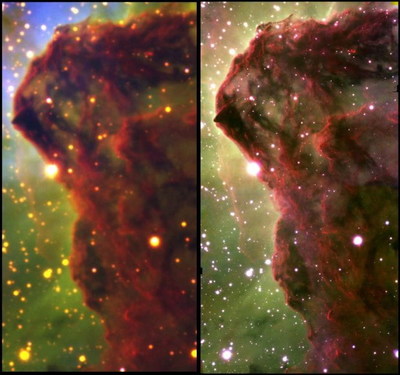Part of a trio of international researchers working on the Gemini South telescope in Chile which captured high resolution imagery of star nurseries
DUBLIN, Oct. 6, 2020 /PRNewswire/ -- DCU academic Professor Turlough Downes has played a key role in a major research development which will significantly expand our understanding of how stars are formed.

Professor Downes, Director of the Centre for Astrophysics and Relativity at DCU and an expert in the theory of star formation, is part of an international collaboration with Prof Pat Hartigan and Asst Prof Andrea Isella, Rice University (USA) and the USA's National Science Foundation NOIRLab which captured near-infrared images of the Carina Nebula, a large and complex area containing massive stars and dusty molecular clouds in the constellation Carina, in which stars are born.
The team gathered images at the international Gemini Observatory, (a program of the USA's National Science Foundation's NOIRLab) in 2018 which shows the "Western Wall", part of a molecular cloud about 7,500 light years from Earth. All stars, including Earth's sun, are thought to form within molecular clouds like this one.
Images of star-forming regions taken from Earth are usually blurred by turbulence in the atmosphere. However, the quality of the images from the Gemini Observatory, which uses Adaptive Optics to increase the resolution by roughly a factor of 10, are equal to that of the James Webb Space Telescope which is planned to succeed the Hubble Space Telescope as NASA's flagship astrophysics mission in late 2021. These images give us a glimpse of what will be possible when the James Webb Space Telescope finally launches.
Commenting Prof Downes said,
"This region is the nearest to Earth where very massive stars are forming and the images are truly breathtaking. They give us real insight into what is going on in massive star forming regions. The quality of the data has allowed us to discern important clues to the physics happening here. It is amazing to think that, right now, there are stars and planets forming in this region and that we have the privilege of looking in on these births."
"The results are stunning," remarked Prof Pat Hartigan, Rice University. "We see a wealth of detail never observed before along the edge of the cloud, including a long series of parallel ridges that may be produced by a magnetic field, a remarkable almost perfectly smooth sine wave and fragments at the top that appear to be in the process of being sheared off the cloud by a strong wind."
The group used the 8.1 meter telescope of the Gemini Observatory which has a wide-field adaptive optic camera to capture the images which provide extraordinary detail and clarity and a wealth of new information to astronomers and scientists alike to help create a deeper understanding of star formation.
The images show a cloud of dust and gas in the Carina Nebula known as the Western Wall. The cloud's surface is slowly evaporating in the intense glow of radiation from a nearby cluster of massive young stars. The radiation causes hydrogen to glow with near-infrared light, and specially designed filters allowed the astronomers to capture separate images of hydrogen at the cloud's surface and hydrogen that was evaporating.
The findings are published in the Astrophysical Journal Letters.
The research was supported by Rice University.
Notes to the editor:
Professor Turlough Downes (@TurloughDownes) is a Professor of Mathematics and Astrophysics at Dublin City University and Director of CfAR (Centre for Astrophysics and Relativity). Prof Pat Hartigan is a Professor of physics and astronomy at Rice University. Asst Prof Andrea Isella is an Associate Professor of Physics and Astronomy and of Earth, Environmental and Planetary Sciences, also at Rice University.
Photo: https://mma.prnewswire.com/media/1308118/DCU_star_formation.jpg


